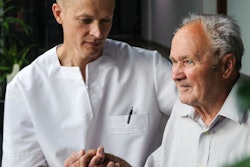
The COVID-19 pandemic has created disruptions at long-term care facilities, and these have created opportunities to transform oral health for older adults for the better, according to a report published by the Gerontological Society of America (GSA).
Oral health advocates can use the pandemic to accelerate changes that will improve the dental health of older adults, such as working to get dental coverage added to Medicare and implementing mobile dentistry for patients with dementia.
"We have a mandate -- ethical, moral, and clinical -- to get things right going forward," Terry Fulmer, PhD, president of the John A. Hartford Foundation, said in a webinar, according to the report. The report was published on April 8 and titled "Pandemic-Driven Disruptions in Oral Health: 10 Transformative Trends in Care for Older Adults."
The GSA created the report based on its webinar series about the challenges of geriatric health and COVID-19. The report shows how COVID-19 revealed a broken elder care system, while offering a window to improvements.
Addressing access issues
Oral health champions need to focus on the dental workforce and a lack of dental coverage.
Despite ongoing efforts, most people lose their private dental insurance coverage at retirement, and Medicare doesn't cover most dental procedures. About 20% of older adults in the U.S. have untreated tooth decay, and 10% of the total Medicare population in 2015 did not see a dentist solely due to cost, Fulmer said.
"The cost of adding this basic and preventive Medicare benefit is $29 per beneficiary per year," Fulmer said. "Doesn't that sound like something we can afford?"
Fulmer warned that the changing oral health workforce must also be addressed.
Due to the potential risks during COVID-19 and insufficient supplies of personal protective equipment (PPE), more older clinicians have decided to suspend their practices, limit the procedures they perform, or permanently retire, Fulmer said. This could reverse a previous trend of dentists retiring later in their careers.
"Since the recession of 2008, the average retirement age of dentists had risen dramatically, from 66.5 years in 2008 to 69.4 years in 2018," she said. "That trend may be reversed as data from the pandemic era are collected."
Permanently using teledentistry
The pandemic forced clinicians to adopt teledentistry and teletriage, and many say now is the time to push for its continued use, added Dr. Michael Helgeson of Apple Tree Dental. His company not only provided care but also convinced administrators and clinicians of the need to restart in-person care for residents.
His teledentistry team taught long-term care facility staff how to take useful images of patients' mouths for transmission to centrally located providers and worked to obtain coverage through Medicaid waivers.
"Oral health services have been on a back burner," Helgeson said. "These were not the top priority areas during the early phase of the pandemic."
It took time to meet with facility administrators and to get them to agree to restart services for their residents, he acknowledged.
"The tasks now are to keep those services higher on the list of resident and patient needs and make teledentistry a permanent option for triaging patients and providing care under Medicaid and other plans," Helgeson said.
Implementing mobile dentistry for patients with dementia
Mobile dentistry is ideal for patients with dementia because then they don't need to be transported to a dental office. Patients with Alzheimer's disease and other types of dementia often are afraid of new environments and unfamiliar faces, said Dr. Jeffrey Dodge, another webinar speaker. Dodge provides mobile dentistry services to long-term care facilities in Rhode Island through CareLink.
"We are able to do simple extractions and restorative work," Dodge said, according to the report. "We can fix broken teeth with sharp edges that are digging into the tongue or inside of cheeks."
Managing chronic conditions
Patients and health professionals have recognized that ignoring preventive care can worsen chronic conditions when a person's dental health declines.
This recognition gives oral health advocates an opportunity to support the earlier use of conservative approaches to treat caries in frail and dependent older adults, said Dr. Leonardo Marchini, PhD, from the University of Iowa College of Dentistry and Dental Clinics. Such interventions include the use of silver diamine fluoride (SDF) and atraumatic restorative techniques.
These interventions were used during the pandemic to avoid aerosol-creating procedures; for example, applying SDF allowed clinicians to stabilize patients who couldn't undergo restorative work or preserve teeth until traditional restorative procedures could be performed. He added that dental teams know how to communicate with these patients.
"Using empathic listening and compassionate care, the dentist and hygienist should be able to encourage oral hygiene routines to be maintained despite current stresses about the coronavirus," Marchini said.



















